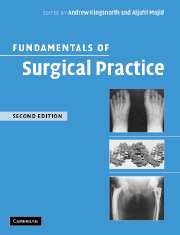Book contents
- Frontmatter
- Contents
- Preface
- Contributors
- 1 Preoperative management
- 2 Principles of anaesthesia
- 3 Postoperative management
- 4 Nutritional support
- 5 Surgical sepsis: prevention and therapy
- 6 Surgical techniques and technology
- 7 Trauma: general principles of management
- 8 Intensive care
- 9 Principles of cancer management
- 10 Ethics, legal aspects and assessment of effectiveness
- 11 Haemopoietic and lymphoreticular systems: anatomy, physiology and pathology
- 12 Upper gastrointestinal surgery
- 13 Lower gastrointestinal surgery
- 14 Hernia management
- 15 Vascular surgery
- 16 Endocrine surgery
- 17 The breast
- 18 Thoracic surgery
- 19 Genitourinary system
- 20 Head and neck
- 21 The central nervous system
- 22 Musculoskeletal system
- 23 Paediatric surgery
- Index
13 - Lower gastrointestinal surgery
Published online by Cambridge University Press: 15 December 2009
- Frontmatter
- Contents
- Preface
- Contributors
- 1 Preoperative management
- 2 Principles of anaesthesia
- 3 Postoperative management
- 4 Nutritional support
- 5 Surgical sepsis: prevention and therapy
- 6 Surgical techniques and technology
- 7 Trauma: general principles of management
- 8 Intensive care
- 9 Principles of cancer management
- 10 Ethics, legal aspects and assessment of effectiveness
- 11 Haemopoietic and lymphoreticular systems: anatomy, physiology and pathology
- 12 Upper gastrointestinal surgery
- 13 Lower gastrointestinal surgery
- 14 Hernia management
- 15 Vascular surgery
- 16 Endocrine surgery
- 17 The breast
- 18 Thoracic surgery
- 19 Genitourinary system
- 20 Head and neck
- 21 The central nervous system
- 22 Musculoskeletal system
- 23 Paediatric surgery
- Index
Summary
SURGICAL ANATOMY
Accurate understanding of the pelvic anatomy is critical to achieving good oncological and functional outcomes after rectal excision. Heald et al. (1998) in Basingstoke introduced the concept of total mesorectal excision during the 1980s. Total Mesorectal Excision (TME) consists of separate high ligation of the inferior mesenteric vessels to define the proximal limits of the lymphatic clearance, followed by rectal mobilisation with sharp dissection under direct vision in the avascular plane outside the mesorectum excising the entire mesorectum and leaving the autonomic nerve plexuses intact. This surgical innovation has been shown to reduce local recurrence dramatically, while maximising the chances of sphincter-preserving surgery.
Permanent impotence in men has been reported to be almost universal in some series of abdominoperineal excisions of rectum and occurs in up to half of all men after anterior resection of the rectum for rectal cancer. The incidence of permanent bladder denervation after rectal excisional surgery has been reported to be up to 19% in some series. The presumed mechanism for sexual and urinary dysfunction is damage to the pelvic autonomic parasympathetic and/or sympathetic nerves during surgery.
The risk of sympathetic nerve damage occurs in the abdomen during ligation of the inferior mesenteric artery pedicle, and high in the pelvis during initial posterior rectal dissection adjacent to the large hypogastric nerves.
- Type
- Chapter
- Information
- Fundamentals of Surgical Practice , pp. 249 - 263Publisher: Cambridge University PressPrint publication year: 2006



